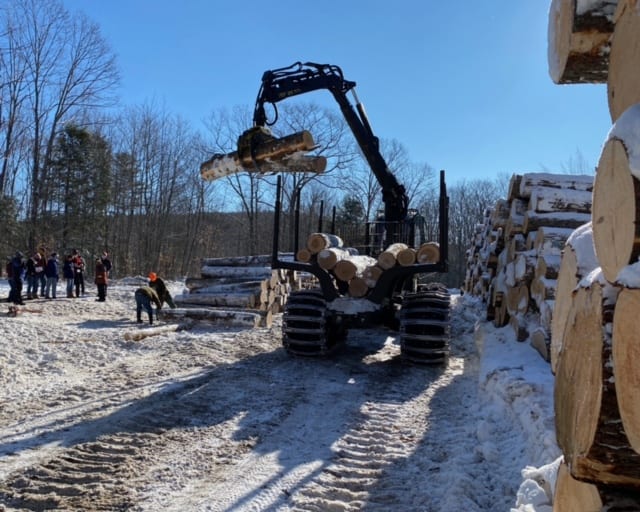Walking up the Alden Hill Road towards the Androscoggin Land Trust’s managed logging operation, the weather was biting cold, about 16 degrees, but clear and crisp. My 14 year old Prius had decided it was not up for the half mile icy climb to the logging yard where I was to meet other members of the ALT Board, as well as the logging crew and Steve Gettle, Maine forester. This morning, Steve was to be our guide on sustainable logging management and how it’s done at the Alden Hill Conservation area.

Arriving at the landing area, I was safely directed around and away from the loader, which swung high over my head, gently moving logs from one enormous stack to the pile high on top of the correct log group.
The ALT members gathered around a fire pit the loggers had made for us. Everyone was rubbing their hands vigorously and stamping their feet to keep the cold from settling in.
Our goal for this morning was to learn about the harvesting operation at Alden Hill Conservation area. Steve Gettle, our guide, had been hired by Androscoggin Land Trust to oversee the selective harvest of trees from this 380-acre conservation parcel. Hardwoods like red oak, red and sugar maples, beech, and ash are typical of this northern hardwood forest, as well as conifers like white pine, hemlock, tamarack, and spruce.
The steps of harvesting are truly fascinating. A forester marks a tree to be removed at its base and again where the tree is to be cut, always looking at the surroundings, marking trees growing too close to each other, and making sure sunlight can reach the forest floor to encourage new growth. Giant harvesters carefully cut and remove trees, doing as little harm as possible to surrounding trees and terrain.
Trees to be harvested are assessed for quality and age, leaving behind trees for later harvest in ten years or more, maintaining and respecting the environment for all creatures great and small who make Alden Hill their home. Logs are then marked and piled by species, the higher quality logs going to the pile for veneer or building boards, others for pallet wood, and finally for pulpwood.
The most fascinating aspect in this process is the classification of logs in the veneer category. The prized logs have to be straight, with no knots or imperfections, and small heart wood. The different species have different market value; each butt end is marked with a code indicating value and company to go to.
After more than two hours, our tour was done except for a hike on the logging trails to see the results of good forest management. Thank you to the loggers and Steve who took the time out of their busy day to educate us on sustainable wood lot management.
-Paula Curtis-Everett, ALT Board Director

